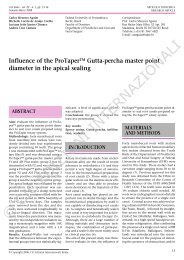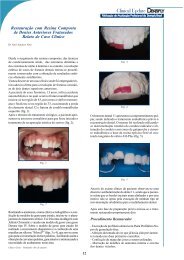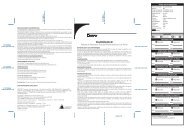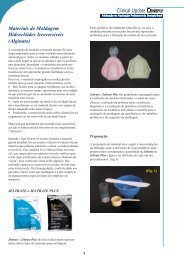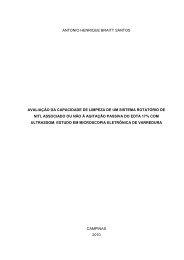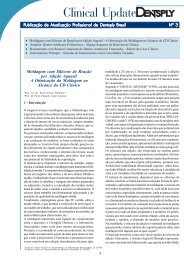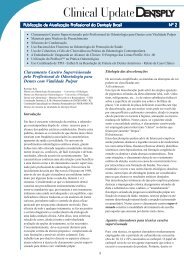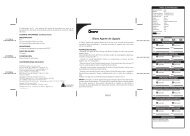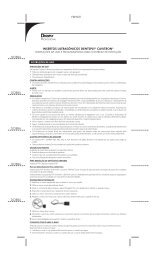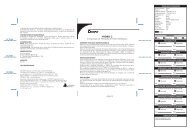Create successful ePaper yourself
Turn your PDF publications into a flip-book with our unique Google optimized e-Paper software.
Ferrari et al<br />
tive sensitivity was found in around 19% of the restorations,<br />
with an average score of 1.9. Only in one case of ten was the<br />
postoperative sensitivity relatively high (score 6), while in<br />
other cases, the sensitivity was not spontaneous. However,<br />
at the 6-month recall, the score dropped from 6 (strong) to<br />
3 (mild). This observation is in agreement with a study that<br />
reported hypersensitivity to be the most common postoperative<br />
complication. 17<br />
The accurate fitting of the crown is another aspect that is<br />
worth mentioning, even though this property was not explicitly<br />
assessed in this paper. A good fitting of the ceramic<br />
restoration can prevent postoperative sensitivity and pulp<br />
complications. In several studies, it had been reported 12,19<br />
that the marginal wear of a composite luting cement can undermine<br />
the mechanical support. To prevent excessive marginal<br />
wear, it is therefore mandatory to have the narrowest<br />
possible gap between the cavity preparation and ceramic<br />
restoration. Optimal fit (ranging from 50 to 100 μm) is preferred,<br />
8 particularly if the margins extend below the cementoenamel<br />
junction. 7,9<br />
A proper adhesive-cement material combination is essential<br />
for avoiding postoperative sensitivity. Other self-activated<br />
bonding systems are available on the market and have<br />
been clinically tested. 5,14 All of them are usually both self-activated<br />
and light cured in order to guarantee complete polymerization<br />
of the bonding layer at the surface (where the<br />
bonding agent can be reached by light) and in deeper areas<br />
where light cannot penetrate to the adhesive layer.<br />
The dual-curing resin cements are used in combination<br />
with the proprietary bonding systems. Accordingly, with the<br />
limits of this study, the mixture of XP BOND with SCA in combination<br />
with chemically curing Calibra showed clinically acceptable<br />
levels of postoperative sensitivity at the 2-week<br />
and 6-month recalls. These findings will be reevaluated during<br />
next recalls at 12 months, and 2 and 3 years.<br />
The utilization of a correct bonding technique is mandatory<br />
to achieve good clinical results in ceramic inlay luting. 9<br />
In direct resin restorations, the bonding agent is routinely<br />
light cured prior to the insertion of the composite. In ceramic<br />
luting procedures, pre-curing of the adhesive resin may<br />
make restoration seating more difficult. Also in this regard,<br />
the use of a self-curing bonding agent is advantageous. In<br />
the present study, a self-curing cement was chosen for luting<br />
the restorations. The self-curing cements are able to<br />
achieve an adequate degree of conversion even at sites<br />
where light curing may be hindered by the thickness of the<br />
ceramic. The setting time of the resin cement can also be directly<br />
correlated to room temperature, glass plate, and<br />
mouth temperature.<br />
CONCLUSIONS<br />
XP BOND used in self-curing mode showed in only one case<br />
of 53 luted restorations a spontaneous postoperative sensitivity<br />
of medium intensity after 2 weeks, which dropped to<br />
a mild grade after 6 months, while all other 9 cases showed<br />
a very low degree of sensitivity.<br />
ACKNOWLEDGMENTS<br />
This research was sponsored by <strong>Dentsply</strong> DeTrey, Konstanz, Germany.<br />
REFERENCES<br />
1. Alavi AA, Kianimanesh N. Microleakage of direct and indirect composite<br />
restorations with three dentin bonding agents. Oper Dent 2002;27:19-24.<br />
2. Bergman MA. The clinical performance of ceramic inlays: a review. Aust<br />
Dent J 1999;44:157-168.<br />
3. Dagostin A, Ferrari M. In vivo bonding mechanism of an experimental dual<br />
cure enamel-dentin bonding system. Am J Dent 2001;14:105-108.<br />
4. Davidson CL. Luting cement, the stronghold or the weak link in ceramic<br />
restorations. Adv Engineer Mater 2001;3:763-767.<br />
5. Fabianelli A, Goracci C, Bertelli E, Davidson CL, Ferrari M. A clinical trial of<br />
Empress II Porcelain inlays luted to vital teeth with a self-light-curing adesive<br />
system and a self-curing resin cement. J Adhes Dent 2006;8:427-431.<br />
6. Ferrari M, Mason PN. Adaptability and microleakage of indirect resin inlays:<br />
an in vivo investigation. Quintessence Int 1993;24:861-865.<br />
7. Ferrari M, Mason PN, Fabianelli A, Cagidiaco MC, Kugel G, Davidson CL. Influence<br />
of tissue characteristics at margins on leakage of class II indirect<br />
porcelain restorations. Am J Dent 1999;12:134-142.<br />
8. Ferrari M, Dagostin A, Fabianelli A. Marginal integrity of ceramic inlays<br />
luted with a self curing resin system. Dent Mater 2003;19:270-276.<br />
9. Frankenberger R, Krämer N, Petschelt A. Technique sensitivity of dentin<br />
bonding: effect of application mistakes on bond strength and marginal<br />
adaptation. Oper Dent 2000;25:324-330.<br />
10. Hahn P, Schaller HG, Hafner P, Hellwig E. Effect of different luting procedures<br />
on the seating of ceramic inlays. J Oral Rehabil 2000;27:1-8.<br />
11. Hickel R, Manhart J. Longevity of dental restorations in posterior teeth and<br />
reasons for failure. J Adhes Dent 2001;3:45-64.<br />
12. Krämer N, Frankenberger R, Pelka M, Petschelt A. IPS Empress inlays and<br />
onlays after four years- a clinical study. J Dent 1999;28:325-331.<br />
13. Krämer N, Lohbauer U, Frankenberger R. Adhesive luting of indirect<br />
restorations. Am J Dent 2000;13:60-76.<br />
14. Krämer N, Frankenberger R. Clinical performance of bonded leucite –reinforced<br />
glass ceramic inlays and onlays after eight years. Dent Mater<br />
2005;21:262-271.<br />
15. Lee IB, Um CM. Thermal analysis on the cure speed of dual cured resin cements<br />
under porcelain inlays. J Oral Rehabil 2001;28:186-197.<br />
16. Manhart J, Scheibenbogen-Fuchsbrunner A, Chen HY, Hickel R. A 2-year<br />
clinical study of composite and ceramic inlays. Clin Oral Invest 2000;<br />
4:192-198.<br />
17. Manhart J, Chen HY, Neuerer P, Scheibenbogen-Fuchsbrunner A, Hickel R.<br />
Three-year clinical evaluation of composite and ceramic inlays. Am J Dent<br />
2001;14:95-99.<br />
18. Millediing P, Örtengren U, Karlsson S. Ceramic inlay systems: some clinical<br />
aspect. J Oral Rehabil 1995;22:571-580.<br />
19. Molin MK, Karlsson SL. A randomized 5-year clinical evaluation of 3 ceramic<br />
inlay systems. Int J Prosthodont 2000;13:194-200.<br />
20. Raffaelli O, Cagidiaco MC, Goracci C, Ferrari M. XP BOND in self-curing<br />
mode used for luting porcelain restorations. Part A: microtensile test. J<br />
Adhes Dent 2007;9:275-278.<br />
Clinical relevance: The results of this 6-month study reveal<br />
good clinical performance of XP BOND in self-curing<br />
mode.<br />
282 The Journal of Adhesive Dentistry



